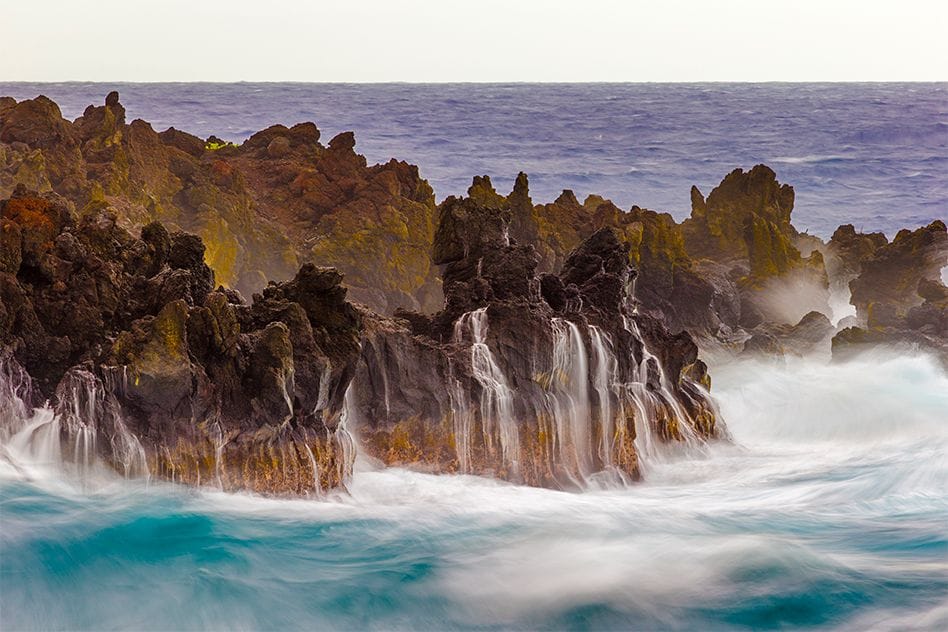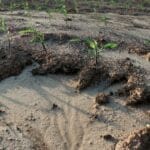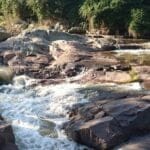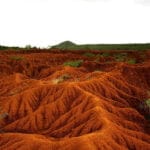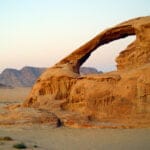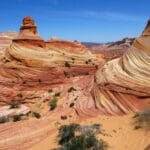While often enjoyed for their beauty and recreational opportunities, waves are a powerful force constantly reshaping our coastlines through erosion. This article delves into the fascinating mechanisms behind wave erosion, exploring how these relentless forces sculpt the dramatic landscapes we see at the edge of the world’s oceans.
Which is One Way That Waves Erode Coastlines?
The immense power of waves to erode coastlines is evident in the dramatic cliffs, sea arches, and hidden coves found along our shores. This constant push and pull between the land and sea is driven by several erosional processes, with waves acting as relentless sculptors of the coastal landscape.
One major way waves eat away at the coastline is through hydraulic action. As waves crash against a cliff face, they force air into existing cracks and crevices. This trapped air becomes compressed, creating intense pressure that can widen the cracks over time. Like tiny jackhammers, these repeated blows can eventually break off large chunks of rock, significantly altering the coastline.
Adding to the erosional power of hydraulic action is abrasion. Waves often carry sand, pebbles, and even larger rocks, effectively turning them into tools for grinding down coastal formations. As waves hurl these abrasive particles against the shore, they act like sandpaper on a grand scale, wearing down cliffs, headlands, and platforms. This constant battering can smooth out rough edges, carve out caves, and gradually change the shape of the coastline.
But wave erosion isn’t just about brute force. Seawater, being slightly acidic, can also dissolve certain types of rock, such as limestone and chalk. This process, known as corrosion, gradually eats away at these softer rocks, creating caves, arches, and other dramatic formations.
What are two ways that waves erode land?
The ongoing battle between the sea and the land is evident in the constant erosion of coastlines. Two primary weapons in the wave’s arsenal are hydraulic action and abrasion, often working in tandem to reshape the coastal landscape.
1. Hydraulic Action: As waves crash against cliffs, they force air into cracks and crevices, compressing the trapped air. This pressure builds until it causes a mini-explosion within the rock, weakening its structure and eventually breaking off chunks. This process, repeated over time, can dramatically change the shape of cliffs and contribute to the formation of coastal features.
2. Abrasion: Imagine the sand swirling around your feet as waves crash on the shore. Now, picture that sand mixed with pebbles and larger rocks, all being hurled against the coastline with the full force of the wave. This constant battering, known as abrasion, acts like sandpaper on a grand scale, wearing down even the toughest rocks and gradually changing the shape of the coast.
Scientists believe the combined forces of hydraulic action and abrasion are responsible for many of the dramatic coastal features we see today. Further research is ongoing to understand fully how these processes interact with other factors, such as climate change and rising sea levels, to influence the future of our coastlines.
How do waves erode wastelands?
The term “wasteland” in this context likely refers to undeveloped or barren coastal areas, often characterized by exposed rock formations, cliffs, or limited vegetation. These areas, while seemingly desolate, are dynamic environments constantly shaped by the erosive power of waves.
As waves travel from deeper water towards the shore, they encounter shallower depths, causing them to slow down and increase in height. This process concentrates wave energy, leading to more forceful impacts against the coastline. The amount of erosion caused by these waves is influenced by factors such as wave size, the angle at which they hit the shore, and the presence of sediments in the water.
Larger waves possess greater energy and can cause more significant erosion, especially when carrying sand and sediment. This sediment-laden water acts like a powerful abrasive, grinding against the shore and accelerating the erosion process. Over time, this relentless wave action carves out dramatic features such as cliffs, wave-cut platforms (flat areas at the base of cliffs), arches, and sea stacks (isolated rock pillars).
Understanding how waves erode wastelands is crucial for coastal management, particularly as sea levels rise and storm surges become more frequent due to climate change. By studying these processes, scientists can develop strategies to protect vulnerable coastlines and manage the impact of erosion on these dynamic environments.
What is one thing that might cause erosion?
While numerous factors contribute to erosion, wave action stands out as a primary force shaping coastlines worldwide. Imagine the relentless pounding of waves against the shore, each one carrying sand and pebbles that act like tiny hammers chipping away at the land.
This abrasive force, combined with the sheer impact of waves crashing against the shore, gradually wears down coastal rocks and soil. The angle at which waves hit the shore also plays a crucial role; waves approaching at an angle create a “sandpaper” effect, exacerbating erosion in specific areas.
The size and sediment content of waves further amplify their erosive power. Larger waves carry more energy and can cause more significant damage, while high sediment concentrations enhance the abrasive action, making waves more effective at carving away at the coastline.
Erosion rates tend to be higher in shallower areas and along cliffs, where wave energy is concentrated due to the decreasing depth. This focused energy leads to the undercutting of cliffs, the formation of wave-cut platforms, and the eventual collapse of overhanging rock, highlighting the dramatic impact of wave action on coastal landscapes.
Which feature is created by wave erosion?
Among the many breathtaking features sculpted by nature, sea cliffs and wave-cut platforms stand out as striking examples of wave erosion’s artistic prowess. Imagine towering cliffs rising majestically from the ocean, their vertical faces bearing witness to the relentless power of the sea.
These sea cliffs are born from the ceaseless assault of waves crashing against the shoreline. Over time, the waves’ energy focuses on areas of weakness in the rock, carving out notches and undercuts. As erosion continues, these notches deepen, eventually causing the overhanging rock to collapse, creating the sheer faces we recognize as sea cliffs.
But the erosive power of waves doesn’t end there. As cliffs erode, they leave behind a flat, gently sloping surface at their base known as a wave-cut platform. This platform, often submerged during high tide, represents a battleground between land and sea, a testament to the ongoing process of erosion and deposition.
The formation of sea cliffs and wave-cut platforms illustrates the dynamic nature of coastlines. These features are not static; they evolve over time, shaped by the relentless forces of wave erosion, offering a glimpse into the awe-inspiring power of nature to sculpt our planet.
How do waves erode the coastline?
The constant dance between waves and coastlines results in a range of erosional processes that shape these dynamic environments. Let’s dive into the fascinating ways waves wear down, reshape, and redefine the land’s edge.
1. The Incredible Force of Hydraulic Action
Imagine the impact of a wave slamming against a cliff face. The sheer force of the water, known as hydraulic action, can be strong enough to dislodge rocks, sand, and other coastal materials. This relentless pounding creates cracks and crevices, weakening the rock structure over time.
As waves continue their assault, these cracks widen, eventually leading to the collapse of large sections of the cliff. The process is similar to using a power washer on a smaller scale; the constant force of the water gradually breaks down the surface, leading to significant erosion over time.
2. Abrasion: Nature’s Sandpaper
Waves are not just powerful forces of water; they also carry a payload of sediment, including sand, pebbles, and even larger rocks. As these particles are churned about by the waves, they act like sandpaper, grinding against the coastline and wearing it down.
This process, known as abrasion, is particularly effective when waves carry larger and heavier sediments. The constant scraping and grinding action can smooth out rough surfaces, carve out caves, and contribute to the formation of unique coastal features.
3. Corrosion: The Chemical Breakdown
While hydraulic action and abrasion rely on physical force, corrosion takes a more subtle approach. Seawater, being slightly acidic, can dissolve certain types of rock, particularly those rich in calcium carbonate like limestone.
This chemical breakdown, known as corrosion, can create intricate patterns and formations in coastal rocks. Over time, corrosion can weaken cliffs, contribute to the formation of caves and arches, and significantly alter the appearance of the coastline.
4. Transportation: Moving Things Along
Erosion doesn’t just break down the coastline; it also involves the movement of eroded material. Waves and currents act like conveyor belts, transporting sediment along the shore and depositing it in new locations.
This constant movement of sediment contributes to the formation of beaches, sandbars, and other coastal features. Understanding how waves transport sediment is crucial for managing coastal erosion and predicting how coastlines might change in the future.
It’s Not an Exact Science
While scientists have made significant strides in understanding coastal erosion, it remains a complex and dynamic process. Factors such as wave energy, sediment type, coastal geology, and human activities all interact in intricate ways, making it challenging to predict exactly how coastlines will respond to erosion over time.
Keep Exploring!
The next time you’re at the beach, take a moment to appreciate the power of the waves and the role they play in shaping our planet. From the dramatic cliffs to the sandy beaches, the coastline is a testament to the ongoing dialogue between land and sea, a dynamic environment sculpted by the relentless force of erosion.
Which is one way that waves erode?
Among the various methods waves employ to sculpt coastlines, abrasion stands out as a primary driver of erosion, a process akin to nature wielding sandpaper against the shore.
Picture this: waves crashing against a cliff face, carrying a slurry of sand, pebbles, and even larger rocks. As these particles are hurled against the shore, they act like a giant sandblaster, grinding away at the rock and gradually wearing it down.
The effectiveness of abrasion depends on several factors, including the size and hardness of the sediment being carried by the waves, the force with which the waves strike the coast, and the resistance of the coastal rocks to erosion. Softer rocks, like sandstone, are more susceptible to abrasion than harder rocks like granite.
This process of abrasion is not limited to cliffs; it also plays a significant role in shaping beaches, smoothing out rough edges, and creating unique coastal landforms. Over time, abrasion can significantly alter the appearance of the coastline, highlighting the powerful forces at play in this dynamic environment.
What are the 2 processes by which waves can cause erosion?
The relentless energy of waves constantly reshapes coastlines through two primary processes: hydraulic action, a force that weakens rocks from within, and abrasion, a grinding action that wears down coastal surfaces.
Hydraulic Action: Imagine a wave crashing against a cliff face, forcing air into every crack and crevice. This trapped air acts like a jackhammer, exerting tremendous pressure on the rock. Over time, this pressure can widen cracks, loosen rocks, and eventually cause large sections to break off.
Abrasion: Picture the swirling mix of sand, pebbles, and even larger rocks carried by waves. As waves crash against the shore, these particles act like sandpaper, grinding away at the coastline. The constant friction from this abrasive action gradually wears down rocks, smooths out rough surfaces, and contributes to the formation of various coastal features.
These two processes, often working in tandem, are responsible for the dramatic cliffs, caves, arches, and other awe-inspiring formations found along our coasts. Understanding these processes is crucial for managing coastal erosion and protecting vulnerable shorelines.
What are two ways in which waves erode the land in Quizlet?
While the term “Quizlet” might imply a specific platform or resource, the question ultimately focuses on two fundamental ways waves erode land: corrosion and hydraulic action.
Corrosion: Imagine the constant back and forth of waves washing over rocks and sediment. This action, combined with the slightly acidic nature of seawater, can gradually dissolve and wear away coastal materials, particularly those containing soluble minerals.
Hydraulic Action: As waves crash against the shore, they can exert tremendous force on cracks and crevices in rocks. The pressure from this force can widen existing cracks and even create new ones, eventually breaking down even the hardest rock formations.
These processes, often working together, contribute significantly to the dynamic nature of coastlines, shaping cliffs, carving out caves, and influencing the distribution of sediment along the shore.
What are two ways that waves can break down rocks?
The relentless energy of waves, combined with the abrasive materials they carry, makes them formidable sculptors of coastlines. Two key processes by which waves break down rocks are abrasion, a grinding action, and attrition, a process of wearing down through collisions.
Abrasion: Imagine waves armed with a slurry of sand, pebbles, and larger rocks crashing against the shore. This relentless bombardment acts like sandpaper on a grand scale, grinding away at cliffs, smoothing out rough edges, and gradually wearing down even the toughest rocks.
Attrition: As waves churn and toss sediment, rocks and pebbles collide with each other and with coastal formations. These constant collisions chip away at the rocks, breaking them into smaller pieces and rounding their edges. This process, known as attrition, contributes to the formation of sand and the gradual wearing down of larger rocks over time.
These two processes, often working together, highlight the powerful forces of nature at play in shaping our coastlines, reminding us of the constant interplay between land and sea.
What are the two methods of erosion?
While erosion encompasses a range of processes, two primary methods by which waves reshape coastlines are hydraulic action, the sheer force of water, and abrasion, a grinding action that wears away at coastal materials.
Hydraulic Action: Imagine the impact of waves crashing against a cliff face. The force of the water can be strong enough to compress air trapped in cracks and crevices, putting immense pressure on the rock. This repeated pressure can widen existing cracks, create new ones, and eventually cause chunks of rock to break off.
Abrasion: Waves act like nature’s sandpaper, carrying a payload of sand, pebbles, and even larger rocks. As these particles are hurled against the coastline, they grind away at the rock, smoothing out rough edges, carving out caves, and gradually wearing down the shore.
These two methods of erosion, often working in tandem, are responsible for the dramatic cliffs, arches, and other stunning formations found along coastlines worldwide. Understanding these processes is crucial for predicting how coastlines might change in the future and for developing strategies to manage the impacts of coastal erosion.
- Master Russian Politeness:A Guide to Saying Please - March 29, 2025
- Master Russian Politeness:Say Please Like a Pro - March 29, 2025
- Mastering King in French: A Deep Dive - March 29, 2025
